The Ark of the Covenant is perhaps history’s most famous archeological relic. I have been fascinated with it ever since watching Raiders of the Lost Ark , the movie that kick-started so many archaeological careers. It is the quintessential missing treasure – an artifact of supposed great power and terror, connected to the supernatural world, crafted from pure gold, and a tangible link to an ancient religion three thousand years old.
Finding it could mean confirming the origins stories of Israel described in the Old Testament, and also the existence of Moses. It could also mean unleashing a new calamity upon the world, for the Ark has always been associated with God’s terrifying destructive powers, as we all remember from Raiders. For instance, 1 Samuel 6:19 relates: “But God struck down some of the inhabitants of Beth Shemesh, putting seventy of them to death because they looked into the ark of the Lord.” According to many Jewish and Christian theologians, its rediscovery could even be a harbinger to the end of the world.
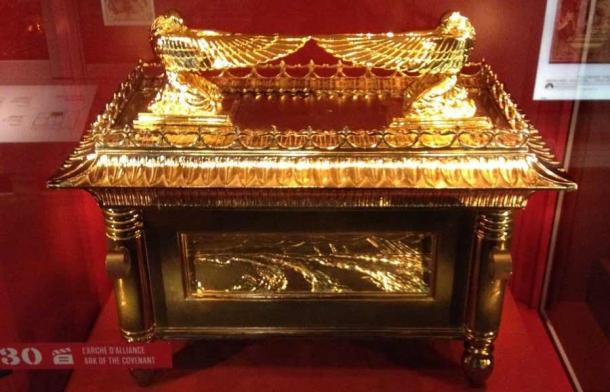
The original Ark of the Covenant prop from the film Raiders of the Lost Ark, on display in Edmonton, Alberta, Canada. (Author provided)
The Origins of the Lost Ark of the Covenant
Built by Moses after the Exodus from Egypt, sometime in the 13th century BC, the Ark of the Covenant was the earliest tangible link between the early Israelites and their god, Yahweh, a deity with no cult statue – a complete novelty in that era. The first mention of the famous golden chest appears early in the Old Testament, in a vast vision of gold and grandeur from God to Moses:
10 “Have them make an ark of acacia wood—two and a half cubits long, a cubit and a half wide, and a cubit and a half high. 11 Overlay it with pure gold, both inside and out, and make a gold molding around it … 17 “Make an atonement cover of pure gold … And make two cherubim out of hammered gold at the ends of the cover … 20 the cherubim are to have their wings spread upward, overshadowing the cover with them. The cherubim are to face each other, looking toward the cover. 21 Place the cover on top of the ark and put in the ark the tablets of the covenant law that I will give you. 22 There, above the cover between the two cherubim that are over the Ark of the Covenant law, I will meet with you and give you all my commands for the Israelites.” (Exodus 25: 10-22)
When not leading the Israelites as the symbolic presence of Yahweh, it was kept in the Holy of Holies in the Tabernacle of Moses. It was connected to miracles and oracles during Israel’s early centuries, and was finally installed in the luxurious temple that Solomon built in Jerusalem. Centuries later it was caught up in the mayhem and destruction of the Babylonian Invasion between 597 and 586 BC, and it was at this point during which the Ark slipped right through the cracks of history. It has been lost ever since, sparking mystery, wonder, and fascination.
Finding the ark would be one of the greatest discoveries in archaeology, but first we need to properly understand it. Why was it made of wood overlaid with solid gold? Why did it have two golden statues of “cherubim” – odd creatures with wings? Why was it carried on two poles? We know Moses saw it first in a holy vision from God, but who was Moses? I believe that only by connecting Moses to the heretic Pharaoh Akhenaten, can we suddenly make much sense of the lost Ark’s origins, functions, and even start to understand where it could be hidden.
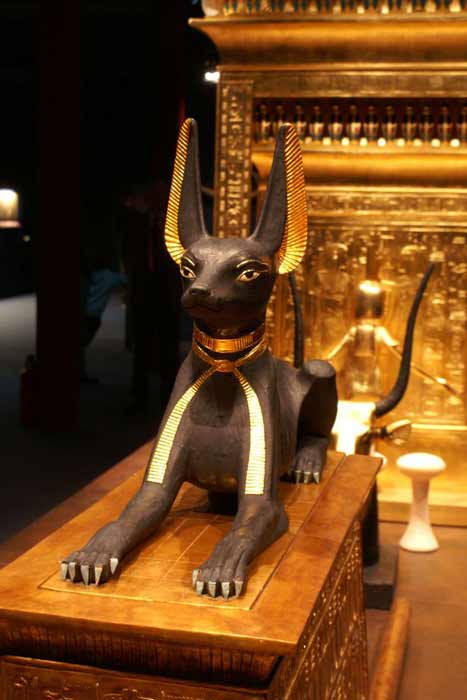
A museum-quality replica of the Anubis shrine from Tutankhamun’s tomb. (Michail / CC BY-SA 3.0 )
Walk like an Egyptian – With a Sacred Barque
In his 2015 article entitled “The Egyptian Origin of the Ark of the Covenant,” Scott B. Noegel points to ancient Egypt of the Late Bronze Age (~1550 – 1200 BC) as the source of inspiration for the lost Ark of the Covenant, specifically the sacred barque. For example, from the tomb of Tutankhamun comes a similar ark, made of wood and covered completely in hammered gold foil. This box was supported by wooden poles from the base, and was surmounted by Anubis, the jackal-bodied god of the dead. The physical dimensions are also very similar between the two chests.
All throughout Egyptian history, the boat, or barque, was seen as the fundamental mode of conveyance, including for the gods. In mythology, Ra sailed through the sky on his solar barque, and through the underworld on his boat of millions of years. During festivals, statues of various gods were placed on thrones inside golden shrines behind veils and paraded above the crowds on two poles by pure-washed priests. Often these barques contained flanking protective creatures, such as winged goddesses or sphinxes, similar to the “ cherubim” of the Ark.
Great examples of the sacred barque are the throne of Amun as inscribed on Seti I’s mortuary temple in Luxor, as well as the barque of Horus in the Edfu Temple . There is also abundant evidence from Luxor and Karnak of these processions of the high god Amun-Ra, whose golden statue was carried in a divine golden litter via two poles very similar to the Ark. These barques dispensed oracles in much the same way the Ark did with Samuel, David, Solomon, and even Moses: “When Moses entered the tent of meeting to speak with the Lord, he heard the voice speaking to him from between the two cherubim … In this way the Lord spoke to him.” (Numbers 7: 89).
In 1 Samuel 4:4, the ark is likened to the throne of God in a very royal sense: “…and they brought back the ark of the covenant of the Lord Almighty, who is enthroned between the cherubim.” This was indeed common of the Bronze and early Iron Ages not only in Egypt but across the Near East – thrones of cherubim were always seats of gods and kings. A good example is the sarcophagus of Phoenician king Ahiram (9 th century BCE), on which the king is depicted on a cherub throne. Winged sphinxes have been found all through this time period, including beautiful ivory sculptures from Megiddo and Samaria, and they generally appear to derive from older Egyptian prototypes.
Another function of sacred barques was to be the repository of covenant agreements, as in the case of Ramses II : “The writing of the covenant that I made to the Great King, and which the King of Hattu has made with me, lies beneath the feet of the god Ra. The great gods are witnesses to it.” This is one of the Ark’s prime functions – to be the repository of the Law of the Covenant between Yahweh and Israel: “Then put in the ark the tablets of the covenant law, which I will give you” (Exodus 25:16). We can much better understand Moses placing his new Yahweh-Israel covenant inside the Ark if we imagine it as the sacred barque of Yahweh at whose “feet” Moses laid the “writing of the law of the covenant.”
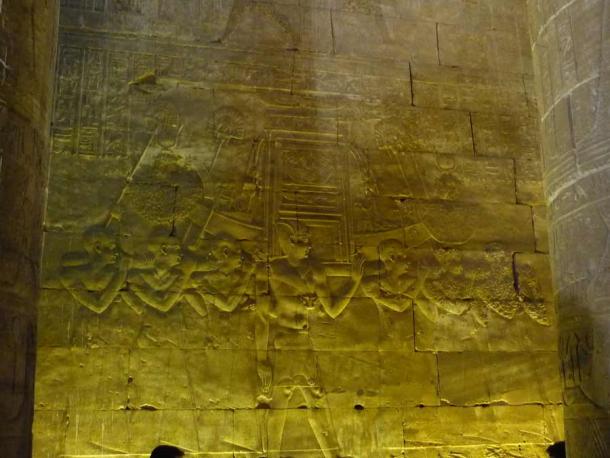
Purified priests carry the sacred barque of Hathor in a wall relief from the Hypostyle Hall at the Edfu temple. Pharaoh walks beside them. (I, Rémih / CC BY-SA 3.0 )
The Tabernacle of Moses as Amarna 2.0
Akhenaten ruled from 1373 to 1337 BCE and has been called Egypt’s Heretic King because he altered nearly every traditional aspect of Egyptian life. He installed a new monotheistic deity called the Aten, who was depicted as a sun disc with rays ending in life-bearing hands, and shockingly not as a human or animal, as were all the other Egyptian deities. The king ultimately forbade and persecuted nearly all of the traditional gods, and after his death, most of his city and temples were purposefully and hatefully destroyed. You can still visit the ruins of his city in Middle Egypt – the once sprawling metropolis of “Akhet-Aten” which is known today as Amarna.
Amarna guru Barry Kemp notes that Egyptian temples during Akhenaten’s time had many cultic objects, the most important of which were either made of solid metal (gold, silver, or bronze) or wood overlain with gold leaf. This is identical to the Tabernacle of Moses, which contained both metallic objects and wooden ones overlain with gold leaf, such as the lost Ark of the Covenant. The best examples to survive intact from this period are the gilded items from Tutankhamun’s tomb, including the Anubis shrine. When the Tabernacle of Moses and its equipment are compared to Tutankhamun’s treasures and Akhenaten’s Great Aten Temple, we find abundant similarities.
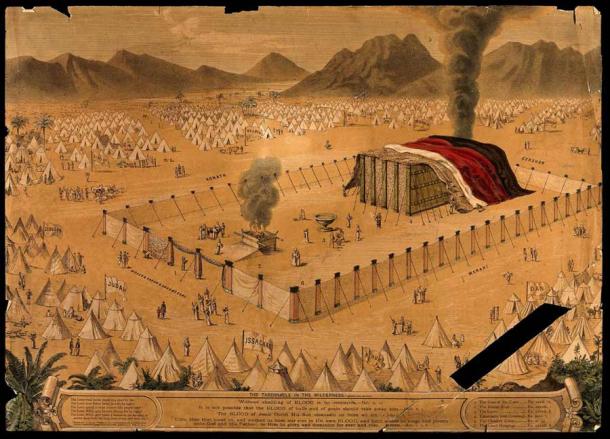
Colored lithograph showing the Tabernacle of Moses. (Wellcome Library / CC BY 4.0 )
They are both elongated structures with three areas of increasing holiness. Both have gilded wooden tables topped with twelve distinct flat, circular bread loaves, burning incense on golden stands, washing basins, slaughter courts and altars, and even tent structures. Both also have relatively small sanctuaries at the heart of their respective structures. Interestingly, while we see analogues between these buildings in nearly all facets, the one object curiously without a parallel remains the Ark itself, the holiest of all objects. If Moses was intent on reinventing his former religion, what served as the proto-type for the Ark? I believe the answer lies in the Royal Litter of Akhenaten.
This glittering golden vehicle is depicted in reconstructed scenes from Karnak, as well as from Amarna. It was carried on two poles and had two winged sphinxes flanking the king and queen in a similar fashion as the cherubim. We have abundant evidence of his family’s love of sphinx imagery. It was his grandfather, Thutmose IV, who restored the Great Sphinx of Giza after dreaming of the giant statue, and he and his son, Amenhotep III, were depicted as winged sphinxes on thrones. Meanwhile, his mother, Queen Tiye, has been found depicted as a winged sphinx on a beautiful sardonyx amulet, as well as a winged sphinx with a winged cobra behind her on a throne. Could these winged sphinxes have been so important to Akhenaten to have served as the model of the cherubim?
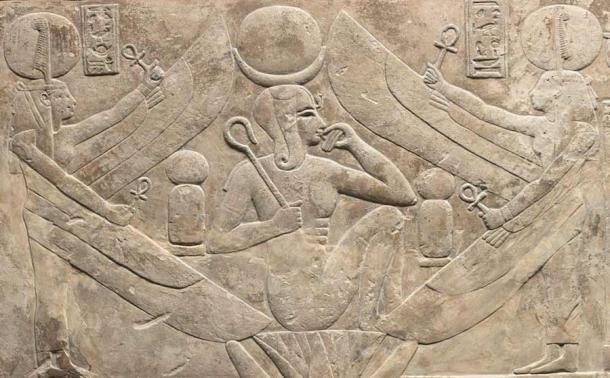
A scene from the Stela of the High Priest of Ptah, Shedsunefertem, showing the two winged figures of Ma’at, goddess of truth, protecting Ra, in the form of a child. This is very similar to how the Ark is described. Now in the Cleveland Museum of Art. (Cleveland Museum of Art / CC0)
Akhenaten in particular viewed his deity, the Aten sun disc, as a royal deity, unlike every other Egyptian god, who was divine, not royal. This would seem to suggest that the Aten could have had his own royal litter, but we have no record of it. However, if Akhenaten were to have created a royal litter for the “royal” deity the Aten, I believe it would have looked very similar to the Ark: a seat flanked by protective creatures with no chair back and only a space for the deity. Interestingly, most depictions of the ark through history have shown it nearly identical to this theoretical royal litter for the Aten: with a sun disc shining proudly down from above or within the cherubim. This seems confirmed in a verse form the Psalms 80:1 in particular: “Hear us, Shepherd of Israel, you who lead Joseph like a flock. You who sit enthroned between the cherubim, shine forth!”
As a final note on the underlying motifs of the Ark, we must mention Akhenaten’s renewed emphasis on the ancient concept of Ma’at. Variously defined as truth, justice, law, order, and righteousness, Ma’at was depicted as a winged human female with an ostrich feather atop her head. Akhenaten associated himself with Ma’at more than any other Pharaoh, mentioning her in all his inscriptions. Now, the very concept of the Mosaic Law is about balance and justice, exactly like Ma’at. I believe the Ark of the Covenant was the primary physical symbol of this: the abode of the Law, covered with the feathered, protective wings of truth.
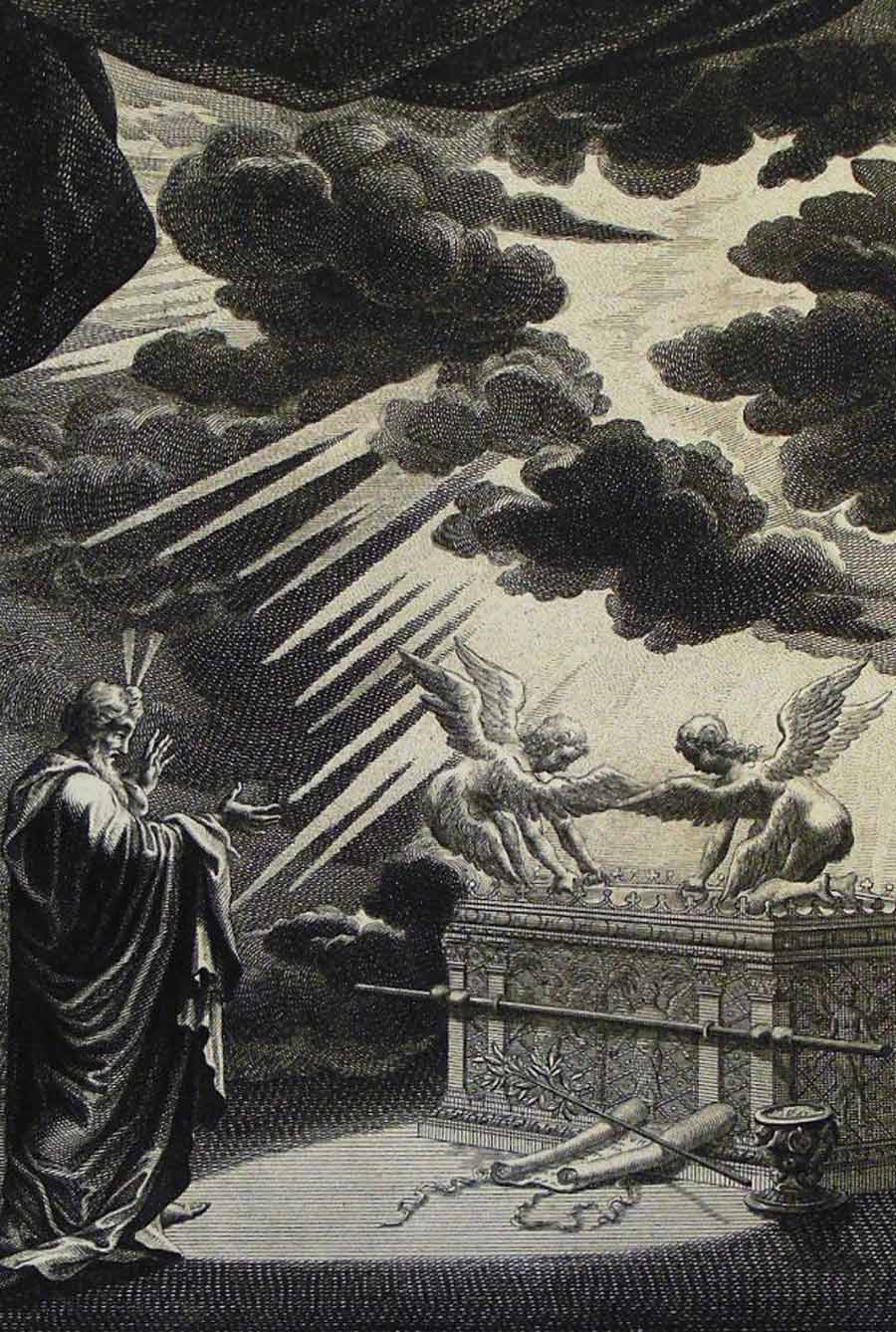
Moses speaks to Yahweh, god of the Israelites, whose presence is between and above the two “cherubim” atop the ark. (Philip De Vere / CC BY-SA 3.0 )
“We Keep on Searching for an Ark of Gold”
For two thousand years now, one of the proposed locations of the missing Ark has been under Mount Nebo in Jordan. Mount Nebo was the mountain which Moses climbed to view the entire Holy Land, as well as on which he later died. Over seven centuries later, as the Babylonian armies closed in on Jerusalem, the prophet Jeremiah supposedly hid the ark on Mount Nebo:
“He (Jeremiah) went out to the mountain where Moses had gone up and had seen the inheritance of God. 5 Jeremiah came and found a cave-dwelling, and he brought there the tent and the ark and the altar of incense; then he sealed up the entrance. 6 Some of those who followed him came up intending to mark the way, but could not find it. 7 When Jeremiah learned of it, he rebuked them and declared: “The place shall remain unknown until God gathers his people together again and shows his mercy. 8 Then the Lord will disclose these things, and the glory of the Lord and the cloud will appear, as they were shown in the case of Moses ….” (2 Maccabees 2: 4-8)
I believe there are many secret connections between Akhenaten and Mount Nebo. While it has been suggested that Nebo derived from the Hebrew words nabi’ (“prophet”), nabah (“prominent”), or even from Nabu, a Babylonian deity of wisdom and writing, I believe the real secret of its etymology lies in an even earlier word: nebu, the Egyptian word for gold. It was a favourite of Akhenaten’s, and thus Mount Nebo could also translate as “Mount of Gold”.
Ironically, this is the very name of Ra, the god so revered by Akhenaten: “Mountain of Gold” (the Aten was the physical presence of Ra). How fascinating that Moses would die and be buried in the Mountain “of Gold” – a metal believed indestructible and eternal by the Egyptians, and associated with mountain tombs, death, and resurrection. Gold was central to sacred kingship in Egypt, and we know Akhenaten and his court were swimming in it.
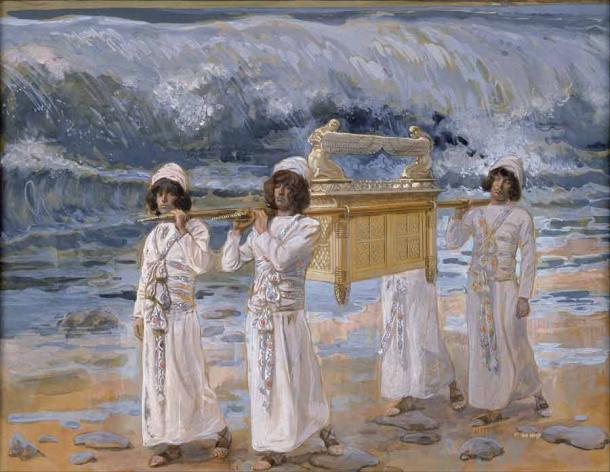
Painting of the now-lost Ark, entitled “The Ark Passes Over the Jordan” by James Tissot. ( Public domain )
A second feature concerns the location of Mount Nebo in relation to Israel: due east. Originally, Akhenaten had his Royal Tomb excavated in the “eastern mountain of Akhet-Aten,” suggesting his wish to be entombed due east of his city within a holy mountain (even though his tomb was found empty and unused). This was a unique feature of Akhenaten – his intended burial due east of his community, in order to be the first to see the sun rise. This contrasted with the ubiquitous Egyptian practice of burial in the west. Thus, Mount Nebo, a mountain due east of the Promised Land, is exactly where Akhenaten would have wanted to be buried, so he would be the first to see the sun rise, forever.
Was Jeremiah simply hiding the lost Ark on Mount Nebo in order to reconnect it with its creator, the prophet Moses? Or had he some inkling that Moses’ life hid a secret Egyptian aspect, a distinctively royal one, and that only on the so-called “Mount of Gold,” where their great prophet and secret king Moses still lay, would the ark be truly safe until the future time of restoration? For example, in the Treatise of the Vessels (the oldest surviving copy of which, from a 1648 book called Emek Halachah , was only recently translated into English in 2014) we read that the Ark: “shall not be revealed until the day of the coming of the Messiah son of David…”
In summary, I believe Akhenaten synthesized numerous motifs to produce the lost Ark of the Covenant, in a similar manner as the Menorah lampstand. He integrated complex themes and motifs of a holy reliquary, divine throne, truth and justice, and fused them with the Law and Covenant of the nascent Israelite nation. It is best to image the Ark of the Covenant as a complex relic of older features joined into a wonderful new symbol. Like the Menorah, it served as a memorial to Moses’ time in Egypt, as well as a link to the future. For one day, when God “gathers his people together again and shows His mercy,” that secret spot where Jeremiah hid the golden chest so long ago will finally be revealed, and we will all gaze and marvel upon Akhenaten’s lost Ark.
“Arise, O Lord, and go to your resting place, you and the ark of your might.” (Psalms 132: 8)
Top image: A composite image of the now-lost Ark of the Covenant with the Aten set above the Mercy Seat. Under Moses, Yahweh retained many key Aten features, such as light, rays, and brilliant power, and is often described as “shining”, “rising” or “dawning”. Source: Author provided
By Jonathon A. Perrin
References
Davies, N. de G. 1903-1908. T he Rock Tombs of El Amarna: Parts I-VI . London: Egypt Exploration Fund.
Dodson, A. 2014. Amarna Sunrise: Egypt from the Golden Age to Age of Heresy . American University in Cairo Press, Cairo.
Eichler, R. No date. “What Kind of Creatures are the Cherubim?” in The Torah . Available at: https://www.thetorah.com/article/what-kind-of-creatures-are-the-cherubim
Falk, D. 2020. The Ark of the Covenant in its Egyptian Context: An Illustrated Journey . Hendrickson Publishers: Massachusetts.
Farber, Z. “The Cherubim: Their Role on the Ark in the Holy of Holies” in The Torah . Available at: https://www.thetorah.com/article/the-cherubim-their-role-on-the-ark-in-the-holy-of-holies
Grintz, Y. M. and Freedman, H. 2007. “Ark of the Covenant” in Berenbaum, M. and Skolnik, F. (eds). Encyclopaedia Judaica . 2nd ed. Vol. 2. Detroit: Macmillan Reference USA. pp. 466–469.
Haran, M. 1963. “The Disappearance of the Ark” in Israel Exploration Journal , Vol. 13, issue 1, pp. 46–5.
Kohler, K. and Eisenstein, J. D. No date. “Coffin” in Jewish Encyclopedia . Available at: https://www.jewishencyclopedia.com/articles/4453-coffin
Manners, G. 28 July 2017. “Can the Bible, Bones, and Bronze Age Jugs Finally Pinpoint the Tabernacle that Housed the Ark of the Covenant?” in Ancient Origins . Available at: https://www.ancient-origins.net/news-history-archaeology/can-bible-bones-and-bronze-age-jugs-finally-pinpoint-tabernacle-housed-ark-021533
Matić, U. 2017. ““Her striking but cold beauty”: Gender and violence in depictions of Queen Nefertiti smiting the enemies” in Matić, U and Jensen, B. (Eds) Archaeologies of Gender and Violence . Oxford, Philadelphia: Oxbow Books.
Metzler, M. 2021. “The Ark of the Covenant” in Bible Odyssey . Available at: https://www.bibleodyssey.org/people/related-articles/ark-of-the-covenant
Murnane, W. J. 1995. Texts from the Amarna Period in Egypt . Atlanta, GA: Scholars Press.
Ninan, M. M. A Study on Cherubim. Available at: http://docplayer.net/158662753-A-study-on-cherubim-cherubim-prof-m-m-ninan.html
Noegel, S. 2015. “The Egyptian Origins of the Ark of the Covenant” in Levy, T. E., Schnieder, T. and Propp, W. H. C. (eds.) 2015. Israel’s Exodus in Transdisciplinary Perspective: Text, Archaeology, Culture, and Geoscience. Quantitative Methods in the Humanities and Social Sciences , 2. New York: Springer, pp. 223-242.
Pruitt, S. 2014. “Fate of the Lost Ark Revealed?” in History.com. Available at: https://www.history.com/news/fate-of-the-lost-ark-revealed
Rifai, M. & El Hadidi, N. 2010. “Investigation and analysis of three gilded wood samples from the tomb of Tutankhamun. Decorated Surfaces on Ancient Egyptian Objects” in Technology, Deterioration and Conservation, pp. 16-24.
Rossi, B. 2020. “Reshaping Jeremiah: Scribal strategies and the prophet like Moses” in Journal for the Study of the Old Testament , Vol. 44, Issue 4.
De la Torre, M. A. and Mattfeld, W. 2010. “God’s “Mercy Seat” atop the Ark of the Covenant” in Bible Origins . Available at: http://www.bibleorigins.net/cherubthroneside.html
Wood, A. 2008. “Of Wings and Wheels: A Synthetic Study of the Biblical Cherubim” in Beihefte zur Zeitschrift für die alttestamentliche Wissenschaft 385. Berlin: de Gruyter.
Related posts:
Views: 0
 RSS Feed
RSS Feed















 June 10th, 2021
June 10th, 2021  Awake Goy
Awake Goy  Posted in
Posted in  Tags:
Tags: 
















